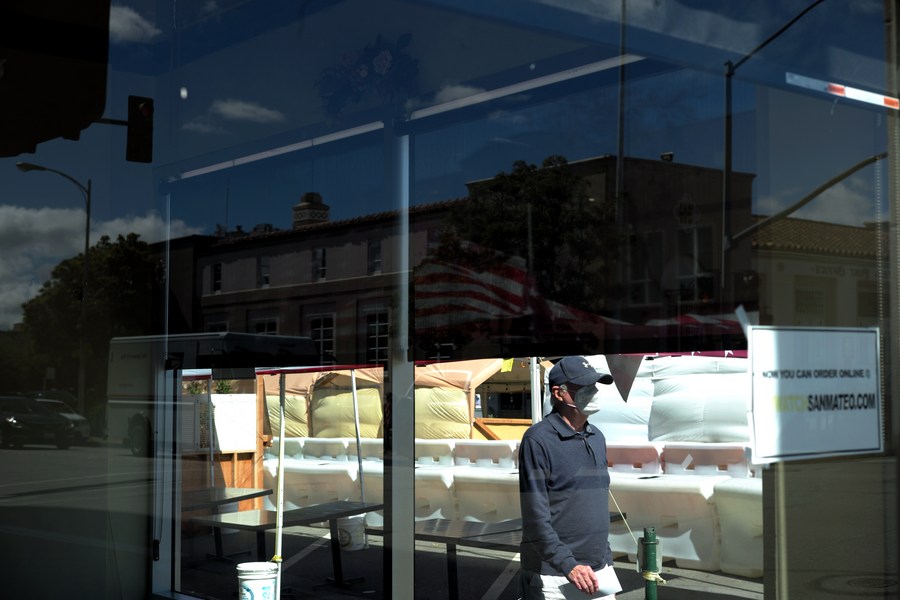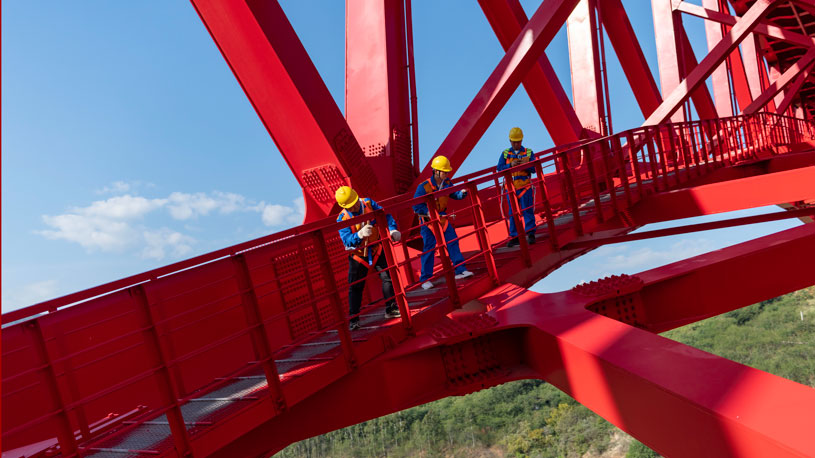Video: U.S. most populous county Los Angeles is expanding access to free COVID-19 testing amid an explosive surge in new cases. (Xinhua)
The fast-spreading Omicron variant has fueled a rise in COVID-19 cases to levels far beyond any recorded in the United States since the start of the pandemic.
NEW YORK, Jan. 21 (Xinhua) -- Despite the wide availability of vaccines and novel treatments, the United States is still experiencing its most significant surge of COVID-19 on record due to the highly transmissible Omicron variant and tens of millions of eligible Americans remaining unvaccinated.
It is hard for health agencies and experts to be sure of an ending date for the current wave.

A man wearing a face mask walks on a street in Manhattan of New York, the United States, Jan. 19, 2022. (Xinhua/Wang Ying)
HOSPITALIZATIONS PUSHED UP
The number of people hospitalized with the virus nationwide and those sick enough to require intensive care remain at or near record levels. In much of the West, in parts of the Midwest and in more rural areas of the country, where Omicron surges have hit later, cases and hospitalizations are still growing significantly. "The country remains far from the end of the Omicron wave," reported The New York Times on Friday.
Most of the decrease in new hospital admissions has so far been in areas that experienced Omicron outbreaks earliest. Omicron reached many metropolitan areas in the eastern half of the country before it became the dominant variant nationwide, and hospitalizations jumped quickly in the Northeast and the South before the new year. Now, hospitalizations are beginning to level off in the Northeast in particular, said the report.
Hospitalizations in the Midwest are also plateauing, but the region still has high numbers of people in intensive care. That is in part because Midwestern hospitals were already stretched thin by the Delta variant surge when Omicron arrived in early December. In Southern states, hospitalizations and ICU rates were among the lowest in the country just before Omicron, but they have sharply risen with the latest wave, it added.

People visit the National Mall in Washington, D.C., the United States, Jan. 17, 2022. (Photo by Ting Shen/Xinhua)
"The fast-spreading Omicron variant has fueled a rise in COVID-19 cases to levels far beyond any recorded in the United States since the start of the pandemic," reported The Wall Street Journal on Friday.
A study, cited in the report, found that for every 10,000 cases of COVID-19 detected outside of a hospital, 110 of those with the Delta variant had symptoms and ended up in the hospital. For those with Omicron, only 16 were hospitalized.
But Omicron variant is estimated to be about three to five times more contagious than Delta. Consequently, the number of people infected is many times greater than during the Delta peak in late summer of 2021. So even though Omicron is less likely to result in severe disease, the sheer scale of infections means the raw number of hospitalizations now exceeds the peak number when Delta was dominant, said the study.
The study conducted by Kaiser Permanente, a California-based hospital and health-insurance company, and funded by the U.S. Centers for Disease Control and Prevention (CDC), examined nearly 70,000 COVID-19 cases in Southern California from Nov. 30 to Jan. 1. It found rates of hospitalization, admission to intensive-care units, mechanical ventilation and death were all substantially lower in patients infected with Omicron.

File photo taken on April 26, 2021 shows a man wearing a KN95 face mask on a street in San Mateo, California, the United States. (Xinhua/Wu Xiaoling)
RISKS FOR UNVACCINATED
Unvaccinated adults age 65 or older who contracted the coronavirus were 49 times more likely to require hospitalization than seniors who had received booster vaccine doses, according to new data from the CDC. Unimmunized adults in that age group were also 17 times more likely to be admitted to a hospital than those who had received either two shots of an mRNA vaccine or one Johnson & Johnson dose.
Meanwhile, unvaccinated people between 50 and 64 years old were 44 times more likely to need hospitalization compared with their boosted counterparts. "The CDC figures on boosters, drawn from between October and December 2021, provide a real-world snapshot of the efficacy of commonly used vaccines in the United States," reported The Washington Post on Friday.
As of Friday morning, a total of 82,450,772 COVID-19 booster doses have been administrated in the United States, or 39.3 percent of the fully vaccinated, according to the CDC's vaccination data tracker. Meanwhile, 209,842,610 people have been fully vaccinated against coronavirus in the country, accounting for 63.2 percent of its total population. ■












